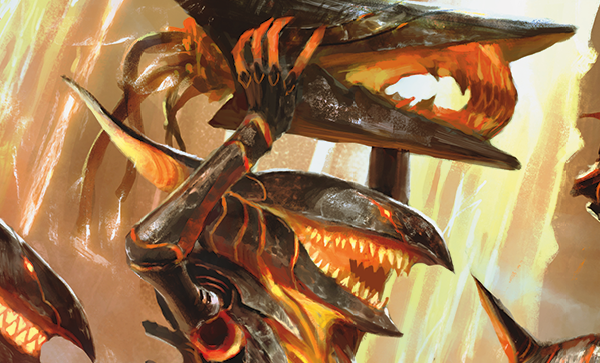Are you a Quiet Speculation member?
If not, now is a perfect time to join up! Our powerful tools, breaking-news analysis, and exclusive Discord channel will make sure you stay up to date and ahead of the curve.
It is here. Phyrexia: All Will Be One brings with it corrupted planeswalkers, Return-of the-Jedidian climactic defeat, and most importantly, a brand-new limited format. We'll dive right into the set's mechanics, then review each color... and at the end, you'll get my top 10 commons and color rankings!
Infect Is Now Toxic
Mechanically, the format skews the gameplay of New Phyrexia (NPH), its spritual forefather. Proliferate returns, and this format offers multiple counters to interact with. While we can still proliferate poison counters, the infect mechanic has been replaced with toxic. Instead of combat damage being dealt in poison counters, our opponents will gain a predetermined number of counters when our creature deals them any combat damage at all. That means no abuse with pump spells.
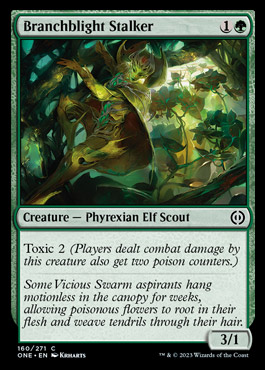
The corrupted mechanic further incentivizes the poison strategy. If your opponent has three or more poison counters, "corrupted" offers various bonuses, making these cards payoffs for running a lot of toxic creatures.
Corrupgrades
Poison isn't the only target for proliferate. Oil counters are another new mechanic. They stack up on permanents and bestow various effects depending on the card, existing in a space similar to charge counters.
"_____" counters
For Mirrodin! is an exuberant rendition of living weapon, but instead of a 0/0 Germ token, we get a 2/2 red Rebel token. The equipment left behind tends to be less powerful, as some of our mana went into the upgraded body.
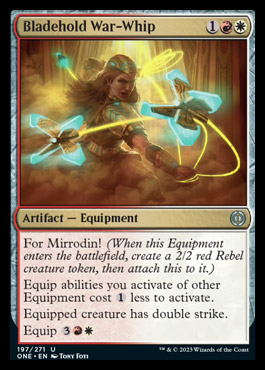
The Dark Triad
Early on, the best color in ONE looks to be white. It's extremely deep with a ton of powerful commons. However, the most powerful thing white has going for it is the synergy between toxic, corrupted, and off-color proliferate effects. Because of the way these mechanics work together, we're incentivized to poison our opponents early. The first counter turns all our subsequent proliferate effects into an additional poison counter, and the third one upgrades many of our cards. The tenth one is pretty good too.
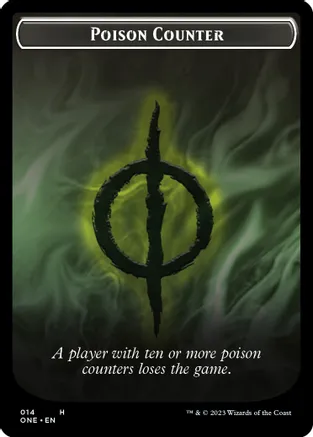
White implements this strategy better than any other color. It has the best ability to aggressively pressure opponents for the first, third, and final poison counter.
The porcelain army at common
Once we've unlocked corrupted, we get additional bonuses, which will lead to snowbally games. This is my biggest concern for the format, but it's also the strategy I'm most excited to try.
To support this onslaught, white is also the best color at making Mites, toxic 1/1s that don't block. The combination of Basilica Shepherd and Indoctrination Attendant churns out a bunch, for instance. The Attendant can also reset Planar Disruption, Ossification, and For Mirrodin! equipment, so don't sleep on the utility of that four-drop.
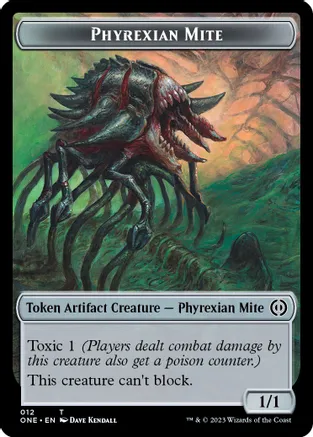
Other colors provide payoffs, but white stands alone when it comes to setting the table. We should expect this to be a contested color, but one that can nonetheless support multiple drafters.
Every deck in the format is going to need to have an answer for white's early game. Falling behind on life, poison, and the advantage corruption provides is devastating. This is the color that will dictate the pace of the format, and will be critical in developing ONE's rules of engagement.
Oil vs. Toxic
In Kamigawa: Neon Dynasty, the format broke down on a spectrum of enchantment to artifact. Green was almost exclusively dedicated to enchantments; white was mostly an enchantment color but dabbled in artifacts. Black wanted a combination of the two, while blue and finally red were more dependent on artifact synergies.
There appears to be a similar spectrum at work in ONE. White is the most toxic color, followed by black. Because so much of blue is focused on proliferation, it makes sense that it can support either side of the spectrum. Green leans closer to oil, but has a few toxic cards. And red has no toxic at all, but plenty of oil.
This potentially reflects the most and least synergistic color pairs. The more "all-in" we are on toxic or oil, the more we gain from their synergies. While we might not rely heavily on either, relying heavily on both toxic and oil feels like a mistake.
The Color of Oil
Red and Green both use oil to enhance their gameplans. Green wants to go big and has great top-end threats to do so. Red has reasonable midrange threats and access to a number of premium commons, but blue can help pump out oil in a big way.
Blue oil
Blue has access to a great mix of oil and proliferate cards. Meldweb Strider might just be a sleeper. When a 1/1 mite could be lethal, vigilance is especially exciting, and a 5/5 looks huge in this format. This is a reason to want to proliferate, and it could be enough to turn Claustrophobia into a desirable card.
Many of its commons play a controlling game, but if we can make Ichor Synthesizer an aggressive card, we might have something in UR.
Izzet real, or trash?
This deck might not be getting enough support from blue to be a consistent player, but the red cards are pretty strong independently. Harnessing the Ichor Synthesizer and strong synergistic pieces is a strategy we should consider. The For Mirrodin! equipment helps us turn on the two-drop and the equipment pairs well with the unblockable Synthesizer.
Green Has an Early-Game Problem
Though green boasts a number of strong commons, the color suffers from a clear weakness when it comes to the early game. The common two-drops both seem eminently replaceable, and the best removal spell is a fight spell, requiring creatures on the battlefield.
Slow and steady
These cards are very powerful, but without early interaction against the corrupted decks, they will often fall short. Whether this top end helps to support our own offensive, or we use defensive cards to develop into the midgame, green will need to be supported in the early game.
In BRO, the most important green common in the format was Citanul Stalwart. Don't be fooled: Rustvine Cultivator is not the second coming of Stalwart, but Thirsting Roots might be.
Is Red Aggressive?
Hexgold Slash and Volt Charge are both excellent removal spells at common. Slash looks especially good. At the start of the format, the Shock is the priority removal spell (for Draft, not Sealed). Being able to dispatch a toxic attacker on our opponent's turn two when we're on the draw will spare us unwinnable game states. It's a testament to the power of the white aggressive decks, but also a precaution to be embraced until proven otherwise.
In our Best of BRO article we awarded Scrapwork Cohort the Uncommon Common award, because it provides so many game pieces. When we get multiple game pieces, we get more agency. For this reason, Barbed Batterfist seems like a premium common, and the other For Mirrodin! equipment seem like overperformers, despite the pricey equip costs on some of them.
Historically speaking, red is the poster boy of aggression in Magic the Gathering. This format has some avenues for red to achieve that status once again, but at common, the deck seems to want to play a more midrange strategy.
Uncommon starts for red
These cards provide a threatening start. They make cards like Free from Flesh, Kuldotha Cackler, and Blazing Crescendo much stronger. If Red Aggro is open, it looks strong, but don't be afraid to skew midrange.
Black Is Shallow
Black has a lot of cards that don't look particularly playable. Its top commons range from good to great, but there's no middle class with black commons. The best ways black has to get corrupted are the measly Pestilent Syphoner and Sheoldred's Headcleaver, which has toxic 2 and menace, but looks pretty soft to the double-block it's asking for. The mosquito probably wants some help with proliferate triggers to push it over the finish line. Sheoldred's Headcleaver pairs really well with Offer Immortality, but why jump through the hoops?
Anoint with Affliction is an efficient removal spell, and Stinging Hivemaster is an above average three-drop. Whisper of the Dross is a card I really want to like, and Bonepicker Skirge will be great if we can activate corrupted, though we already discussed the difficulties that presents.
I wouldn't get into the color for commons, but at higher rarities, we should find more entry points. Black is a solid support color if open. It's the color that most benefits from the self-correcting nature of draft. That is probably the nicest way to put it.
Fixing and Removal
The format has high-quality removal at both common and uncommon. The adage goes there's never a wrong threat, but many wrong answers. In this format, the answers will be right more often than not.
Dies to Doom Blade
These cards will be early picks, but in this format, we should prioritize the early removal to manage toxic threats. On the other hand, this is a format with some absolutely savage bombs. We want to make sure that we aren't dead to our opponent drawing their first pick in a tight game.
My opponent's hand round 1
Either way, the removal looks strong, and necessarily so.
There are a lot of cards that can help us fix our mana in this format, but the cost of fixing is often tempo. If we can build a strong enough defense for the early game, fixing can definitely help us access some off-color bombs. Despite the fixing, a conservative mana base seems like the strongest play out of the gates. It is always best to learn the format's rules of engagement before testing the limits of your greed.
Colorless fixing doesn't exi—
This does not look like a Manalith format, but Dune Mover is an interesting fit. That's right, Campus Guide finally graduated, and the fact that this can fix mana, while playing to the board, while potentially being a toxic threat in our abzan poison-corrupt deck, is very exciting to me.
Top 10 Commons
From best to worst, here are my early pics for the Top 10 commons in ONE Limited:
Color Rankings
- White
- Red
- Green
- Blue
- Black
The drop in quality between white and red is pretty severe. Still, red offers a diverse assortment of tools at common that can make for a strong foundation in a number of different decks. Whether we want an aggressive oil start, or play something more midrange with the removal and above rate creatures, red is a good place to start.
Green’s strong assortment of commons should play well with White, Red, and Blue, as all creatures are able to present an early game, either on offense, defense or both. Besides, it’s not like green provides no early drops, they’re just not as powerful as some of the other colors.
Blue will be a versatile support color for a number of decks. It has the worst removal of the bunch, and a lot of its cards need help to reach their potential. Fortunately proliferation is most available in blue, and through that lens, it can sort of help itself. However, we should always prioritize the colors that work for us over the colors that we have to work for.
The black commons will vary in effectiveness based on the synergies they have with our other cards, however, they are not particularly deep. Until proven otherwise, we should avoid black unless we have a very good reason to head in that direction.
While it’s nice when our color is open, it is equally important to recognize what synergies are open. Each color offers middling commons that can do a lot more if they’re in a deck that optimizes their “archetypical destiny”. Mandible Justiciar is not the two-drop for our toxic deck, however it may be a sign that artifact synergies in WR or UW are available to us. The same can be said for cards like Sawblade Scamp, Plague Nurse, and Annihilating Glare.
Prerelease Fever
There is nothing quite like playing a brand-new limited format, and many of us will get to this weekend. ONE looks to be an exciting landscape with a lot of powerful cards. Bombs always seem bigger in sealed, so be cautious with your removal. We've gotten some great formats recently, and this one looks just as exciting.
Have fun, but be careful out there. Toxic is everywhere. Don't forget to play around Zealot's Conviction and Compleat Devotion, though it may be a luxury we can't afford.


